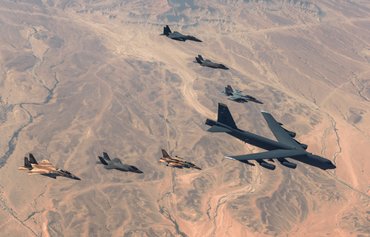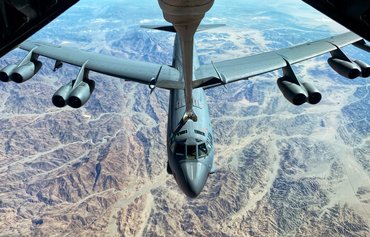The US Air Force's extended-range, combat search-and-rescue (CSAR) capabilities in the Middle East could be used to support the operations of allies across the region.
The US military employs a number of aircraft that are able to insert special forces inside conflict zones around the world, rapidly and with little detection, and to extract them safely when operations have concluded.
Two aircraft in particular are key to this effort: the US Air Force's HH-60 Pave Hawk helicopter and HC-130 Combat King fixed wing aircraft.
Both of these aircraft conduct combat search and rescue (CSAR) missions in hostile environments as well as the insertion and extraction of special forces.
![US Air Force airmen load equipment on a HC-130J Combat King at Tyndall Air Force Base, Florida, August 10, 2017. [US Air Force]](/cnmi_am/images/2023/06/30/42781-hc-130-600_384.jpg)
US Air Force airmen load equipment on a HC-130J Combat King at Tyndall Air Force Base, Florida, August 10, 2017. [US Air Force]
![US troops onboard Air Force HH-60 Pave Hawk helicopters leave to conduct a rescue operation during Exercise Angel Thunder, near the town of Bisbee in Arizona's Sonoran Desert on April 21, 2010. [Mark Ralston/AFP]](/cnmi_am/images/2023/06/30/42770-aaa-600_384.jpg)
US troops onboard Air Force HH-60 Pave Hawk helicopters leave to conduct a rescue operation during Exercise Angel Thunder, near the town of Bisbee in Arizona's Sonoran Desert on April 21, 2010. [Mark Ralston/AFP]
The Pave Hawk is a highly modified version of the Army Black Hawk helicopter that features upgraded communications and navigation.
All Pave Hawks have an automatic flight control system and night vision goggles with an infrared system that greatly enhances low-level night operations.
In addition to performing military operations, the Pave Hawk is tasked with civil search and rescue, medical evacuation, disaster response and humanitarian assistance.
Over the years, HH-60 crews have aided hundreds of American, coalition and foreign-national personnel by conducting personnel recovery and medical evacuations under low visibility, low illumination conditions at all altitudes.
During the 1991 Gulf War, Pave Hawk helicopters provided CSAR coverage for coalition forces in western Iraq, coastal Kuwait, the Arabian Gulf and Saudi Arabia.
Today, they continue to deploy in support of operations in the region.
Avoiding detection
Meanwhile, the HC-130 Combat King is a fixed-wing aircraft primarily designed to conduct recovery operations from austere airfields and denied territory.
The aircraft is an extended-range version of the C-130 Hercules transport.
HC-130 crews employ tactics that include incorporating no external lighting or communications and avoiding radar and weapon detection.
The HC-130 can fly in contested or sensitive environments, both over land and over water.
HC-130s often perform tactical airdrops of special force teams, small bundles, zodiac watercraft, or four-wheel drive all-terrain vehicles.
With a fuel capacity of over 9,000 gallons, the aircraft has a maximum air speed of 316 knots at sea level, and can go up to 33,000 feet (10,000 meters).
The aircraft is also a key part of the US military's refuelling efforts.
HC-130s can perform helicopter air-to-air refuelling -- including at night, with blacked-out communication with up to two simultaneous helicopters -- a key capability that also extends the CSAR range of the HH-60.
Furthermore, the aircraft can execute forward area refuelling point operations to support a variety of joint and coalition partners.
Key capability
This capability allows US Air Force aircraft to prepare for their next mission without having to return to an established base.
This is part of Agile Combat Employment (ACE), which emphasises mobility even in hostile areas where infrastructure is scarce.
The United States has approximately 80% of the global military refueling aircraft.
"The US military's ability to promptly project power over intercontinental distances and sustain operations at theater scales is one of its most significant advantages," said a 2021 Hudson Institute report titled "Resilient Aerial Refueling: Safeguarding the US Military's Global Reach".
"Aerial refueling is arguably the most important contributor to this uniquely American capability," it said.

![Two HH-60G Pave Hawks prepare to refuel from an HC-130J Combat King II during an exercise at an undisclosed location over Southwest Asia, May 30. [US Air Force]](/cnmi_am/images/2023/06/30/42771-230530-f-op776-9072-600_384.jpg)







Important info that confirms how advanced the US is. It also shows its persistent efforts to establish peace across the world.
Reply1 Comment(s)